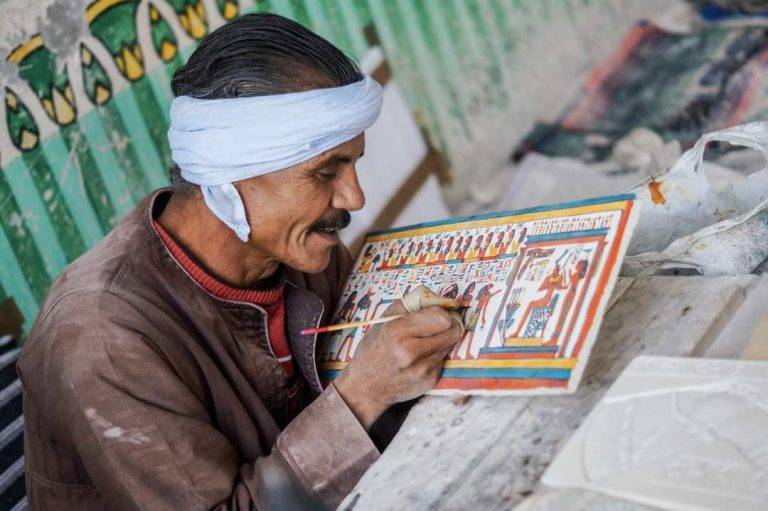Gaddis' store in Luxor
Over a century of family ownership
The exquisite, old-fashioned shop of Gaddis & Co. welcomes guests with signs for books, jewellery, silverware, and other goods on the street level of the Sofitel Winter Palace Hotel, facing the Nile River and just minutes from the Luxor Temple. Racks of curios, ranging from alabaster bowls and stone representations of ancient gods to pharaonic-style bead necklaces, welcome visitors on the inside. Hundreds of books and historical images, largely from the early twentieth century, are displayed on its walls, including Luxor landscapes, temple ruins, and travellers. A big, wooden box camera sits as though at the middle of the stage, the tool that has given solidity to Egypt’s unfolding history. It belonged to Attiya Gaddis, the founder of Gaddis & Co. and one of the earliest Egyptian studio photographers on record. It is a relic in its own right, with plenty of stories to tell.

The Gaddis souvenir shop is a great place to learn about Luxor’s past. Over a century of family ownership. It’s more than a store; it’s a photographic museum. Spend some time looking at Attiya Gaddis’ cameras and photographs of Luxor and Egypt. This is the place to go for original and one-of-a-kind photos of Egypt and Luxor. you can buy unique gifts for your friends and family, and just enjoy browsing. Books, postcards, and, of course, Attiya Gaddis’ photographs are all available.

Attiya Gaddis was born in Toud village in Luxor in 1889, After Attaya’s father passed away when he was a young child, his mother insisted on bringing him to Luxor to get an education.. At the time, Antonio Beato was the only Luxor-based photographer on record. Antonio was a British citizen, who spent the majority of his lengthy career in Luxor. Attiya became the assistant of Antonio. When Beato died in 1906, his widow sold his glass-plate negatives to the Egyptian Museum in Cairo, and the young Gaddis apparently acquired one of his wooden box cameras, which used 30×40-centimeter (12×16″) glass plates and were manufactured in the 1860s: this is the one on display today in the family shop.

At 1907, a year after Beato’s death, Gaddis, then 18 years old, started his studio in the Luxor Hotel. In the days of big discoveries and excavations, he had teamed with Girgus Seif and moved to the Winter Palace hotel in 1912. He extended the studio and darkroom to incorporate what is now a book, jewellery, and souvenir shop.

Seif is a mystery: the relationship ended in 1933 when he wanted to compete with Attiya, but his studio failed miserably. A grandson sold his negatives to a framer after his death, who utilised them as recycled glass. Seif, like Attiya, deserves respect for becoming one of the first Egyptians to enter a profession that had been dominated by foreigners for over half a century.

In 1994, a French archaeologist came to see the photographs by Gaddis and Seif that accompanied Jean Capart’s book Thebes, published in Brussels in 1926, and inquired if there were any more. The contents astounded him. “These photographs are from Egypt’s past.” Ehab began digitising his grandfather’s archive slowly but steadily in the 1990s, and he produced two volumes incorporating Attiya’s work: Memories From The Past (1999) and Egypt’s Native Son (2001). (2005). Tourists and enthusiasts of photography and Egypt continue to flock to Gaddis & Co. to purchase digital prints and postcards from Attiya’s collection.






